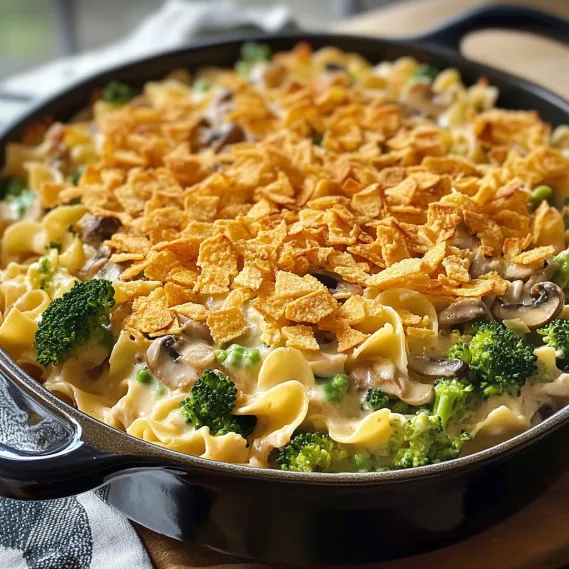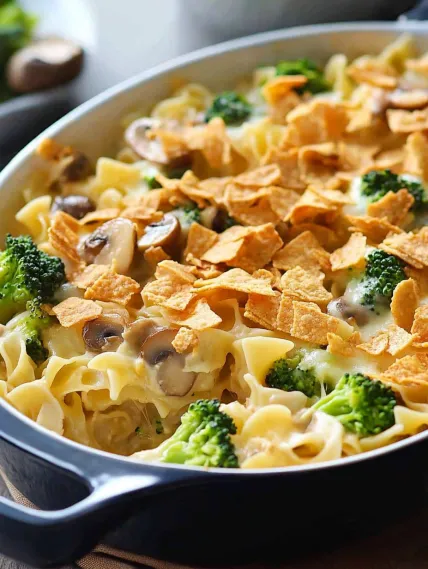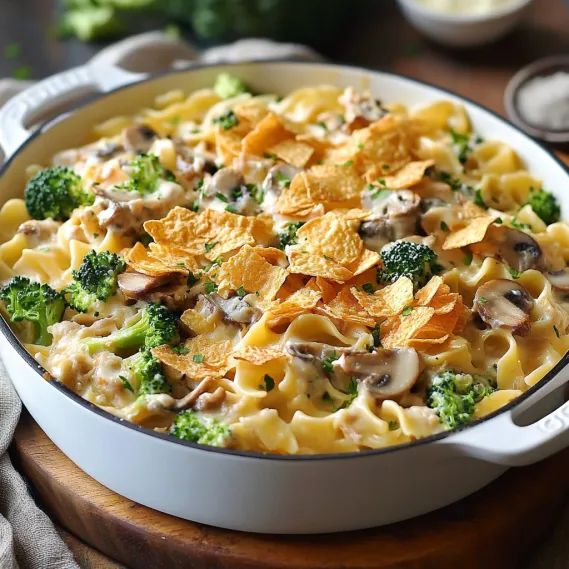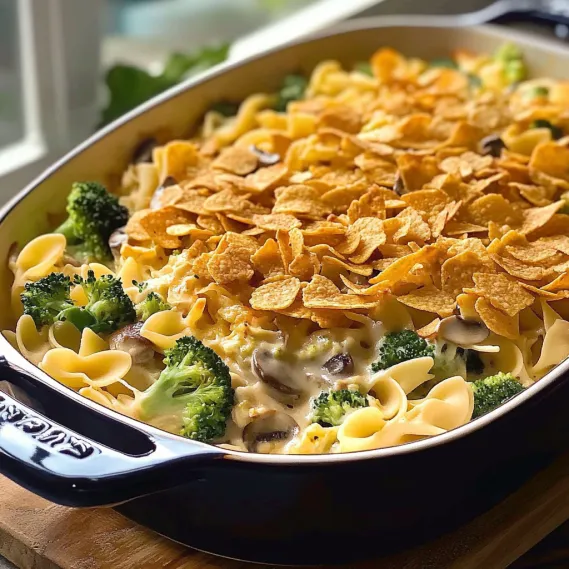 Pin
Pin
Classic Tuna Noodle Casserole combines tender egg noodles, flaky tuna, fresh vegetables and creamy cheese sauce, topped with crispy potato chips. Ready in 50 minutes, it delivers comforting nostalgic flavors perfect for busy weeknights.
I first made this recipe when looking for an impressive yet manageable dish for weekend entertaining. After experimenting with various cuts of shrimp and butter combinations, this version became an instant favorite. My husband declared them the best scampi he's ever tasted, and now guests always request them at our gatherings.
Essential Ingredients and Selection Tips
- Egg Noodles: Medium or wide noodles resist mushiness
- Tuna: Canned in water or oil, drained and flaked
- Vegetables: Fresh or frozen, cut into bite-sized pieces
- Cheese Sauce: Creamy base made with milk, flour, and cheese
- Potato Chips: Thinly sliced, crisped in oven with oil and salt
I've found that adding a small amount of chicken powder (bouillon) makes a significant difference in achieving that authentic takeaway flavor. If you don't have it, mushroom powder makes an excellent substitute that adds similar umami depth without changing the overall profile of the dish.
Detailed Cooking Instructions
- Step 1: Prepare the Casserole Base
- Preheat oven to 400°F. Coat 9x13 baking dish with cooking spray. Organize ingredients before starting as timing matters for pasta. Boil noodles 2 minutes less than package directions. Drain without rinsing to preserve starch.
- Step 2: Cook the Pasta with Precision
- Boil noodles 2 minutes less than package directions. Add broccoli for final 2 minutes. Drain without rinsing to preserve starch.
- Step 3: Prepare Mushrooms for Maximum Flavor
- Dry-sauté mushrooms until golden and liquid evaporates. This concentrates flavor and prevents watery casserole.
- Step 4: Create the Creamy Base
- Sauté onion in butter until translucent. Stir in flour until smooth. Gradually add milk, stirring until thickened. Remove from heat and stir in cheese until smooth.
- Step 5: Combine and Bake to Perfection
- Fold in pasta, vegetables, tuna, and sauce. Top with potato chips. Bake 20-25 minutes until bubbly and golden.

My first attempt at this recipe taught me the importance of having super hot wok before adding ingredients. Now I heat the wok until it's lightly smoking before adding oil, which creates that distinctive restaurant-quality flavor that's impossible to achieve at lower temperatures. This simple technique transformed my homemade fried rice.
The Secret to Non-Sticky Rice
Cold, day-old rice is essential because freshly cooked rice contains too much moisture, resulting in soggy fried rice. Refrigerating rice overnight allows it to dry out slightly, creating perfect individual grains that remain separate when stir-fried. For best results, cook rice with slightly less water than normal.

Creating Authentic Takeaway Flavor
The distinctive taste of restaurant fried rice comes from 'wok hei' – the smoky flavor from high-heat cooking in a well-seasoned wok. Using highest heat possible, cooking quickly, and keeping ingredients moving constantly helps recreate this at home. Don't be afraid of the sizzle and steam – they're signs of good wok hei.
Perfect Protein Balance
Special fried rice stands out because of its generous protein content. Balance is key – prawns should be just cooked to remain tender, eggs should form small, soft pieces throughout, and char siu provides sweet-savory notes. Each protein cooks at different rates, so add them sequentially rather than all at once.
Vegetable Options for Color and Nutrition
Traditional special fried rice includes green peas and carrots, but don't limit yourself. Add diced bell peppers, bean sprouts, sweet corn, or baby corn for extra color and nutrition. For authentic restaurant style, keep vegetables small and uniform to incorporate evenly among the rice grains.
Common Mistakes to Avoid
Overcrowding the wok reduces temperature, creating steamed rather than fried rice. Using too much sauce makes rice soggy. Overcooking vegetables leads to mushy texture. Adding all ingredients simultaneously prevents proper cooking of each component. Extended cooking times result in dry, hard rice grains.

Chef's Helpful Tips
- Use chopsticks or a fork to break up rice grains before cooking
- Cook each ingredient separately before combining for best texture
- Add soy sauce around the sides of the wok for instant caramelization
- Finish with a drizzle of sesame oil for aromatic nutty flavor
- Keep the wok moving constantly to prevent sticking and burning
- If wok sticks to the pan, add a few drops of water and gently loosen with a spatula
- For a complete meal, serve three or four portions of fried rice per person as an appetizer or ten to twelve as a main dish
I've been making variations of this pie for over a decade, constantly refining the technique. The most significant improvement came when I started using the broiler to finish the salmon, creating that perfect balance of crisp exterior and tender, juicy interior.
Recipe FAQs
- → Can I prepare this tuna noodle casserole ahead of time?
- Yes! You can assemble the casserole up to 24 hours before baking. Prepare everything as directed, but don't add the potato chip topping yet. Cover the dish with foil and refrigerate. When ready to bake, remove from the refrigerator 30 minutes before baking to take the chill off, add the potato chip topping, and bake as directed, possibly adding 5-10 minutes to the baking time since it will be starting cold.
- → What can I substitute for cream of mushroom soup?
- If you prefer not to use canned soup, you can make a simple white sauce as a substitute. Melt 3 tablespoons butter, whisk in 3 tablespoons flour and cook for 1 minute. Gradually whisk in 1.5 cups of milk and simmer until thickened. Add 1/2 cup finely chopped sautéed mushrooms and season with salt, pepper, and a pinch of thyme. Alternatively, cream of celery or cream of chicken soup can be used as direct substitutes for a different flavor profile.
- → Can I use a different type of pasta instead of egg noodles?
- Yes, you can substitute the egg noodles with other medium pasta shapes like rotini, penne, or farfalle. The cooking method remains the same - cook them 2 minutes less than the package directions before adding to the casserole. Whole wheat pasta will work too, though it may alter the texture slightly. For a gluten-free option, use your favorite gluten-free pasta but be especially careful not to overcook it initially.
- → What other vegetables work well in this casserole?
- This recipe is very adaptable to different vegetables. Frozen peas (about 1 cup, no need to thaw) can be stirred in just before baking. Other good options include diced bell peppers, small cauliflower florets, zucchini, or corn. For leafy greens like spinach, add them to the hot pasta just before draining to wilt them. Remember that watery vegetables like zucchini may need to be pre-cooked to remove excess moisture before adding to the casserole.
- → What can I use instead of potato chips for the topping?
- Several alternatives work well for the crunchy topping: crushed Ritz or butter crackers, panko breadcrumbs mixed with a little melted butter, French's fried onions, or a mixture of breadcrumbs and grated Parmesan cheese. For a slightly healthier option, try coarsely chopped nuts like almonds or walnuts mixed with a small amount of breadcrumbs and butter. Each option will provide a different but equally delicious crunchy contrast to the creamy casserole.
